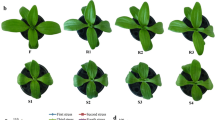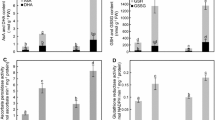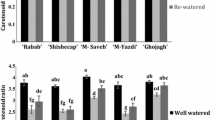Abstract
In order to investigate changes of oxidative status in relation to the activity of the various protective mechanisms in resurrection plant Ramonda nathaliae, we have analysed time and relative water content (RWC) related changes in lipid peroxidation and ion leakage, hydrogen peroxide accumulation, changes of pigment content and antioxidative enzyme activity, together with expression of dehydrins. The results indicate that enhanced oxidative status during dehydration, not previously reported for resurrection plants, could play an active role in inducing the desiccation adaptive response in R. nathaliae. A critical phase is shown to exist during dehydration (in the range of RWC between 50 and 70%) during which a significant increase in hydrogen peroxide accumulation, lipid peroxidation and ion leakage, accompanied by a general decline in antioxidative enzyme activity, takes place. This phase is designated as a transition characterized by change in the type of stress response. The initial response, relying mainly on the enzymatic antioxidative system, is suspended but more effective, desiccation specific protective mechanisms, such as expression of dehydrins, are then switched on. The expression of dehydrins in R. nathaliae could be inducible as well as constitutive. In order to cope with the oxidative stress associated with rapid rewatering, R. nathaliae reactivated antioxidative enzymes. We propose that controlled elevation of reactive oxygen species, such as hydrogen peroxide, could be an important mechanism enabling resurrection plants to sense dehydration and to trigger an adaptive programme at an appropriate stage during the dehydration/rehydration cycle.






Similar content being viewed by others
References
Aebi H (1984) Catalase in vitro. Methods Enzymol 105:121–126
Barrs HD, Weatherly PE (1962) A re-examinationof the relative turgidity technique for estimating water deficits in leaves. Aust J Biol Sci 15:413–428
Bartels D (2005) Desiccation tolerance studied in the resurrecton plant Craterostigma plantagineum. Integr Comp Biol 45:696–701
Bartels D, Salamini F (2001) Desiccation tolerance in the resurrection plant Craterostigma plantagineum. A contribution to the study of drought tolerance at the molecular level. Plant Physiol 127:1346–1353
Beuchamp CO, Fridovich I (1971) Superoxide dismutase: improved assays and an assay applicable to acrylamide gel. Anal Biochem 44:276–287
Bewley JD, Krochko JE (1982) Desiccation-tolerance. In: Lange LO, Nobel PS, Osmond CB, Ziegler H (eds) Encyclopedia of plant physiology. vol. 12B. Physiological ecology II. Springer-Verlag, Berlin, pp 325–378
Beyer WF, Fridovich I (1987) Assaying for superoxide dismutase activity: some large consequences of minor changes in conditions. Anal Biochem 161:559–566
Bradford MM (1976) A rapid and sensitive method for the quantitation of micrograms quantities of protein utilizing the principle of protein-dye binding. Anal Biochem 72:248–254
Cellier F, Conéjéro G, Breitler JC, Casse F (1998) Molecular and physiological responses to water deficit in drought-tolerant and drought-sensitive lines of sunflower. Accumulation of dehydrin transcripts correlates with tolerance. Plant Physiol 116:319–328
Close TJ (1997) Dehydrins: a commonality in the response of plants to dehydration and low temperature. Physiol Plant 100:291–296
Close TJ, Fenton RD, Moonan F (1993) A view of plant dehydrins using antibodies specific to the carboxy terminal peptid. Plant Mol Biol 23:279–286
Collet H, Shen A, Gardner M, Farrant JM, Denby KJ, Illing N (2004) Towards transcript profiling of desiccation-tolerance Xerophyta humilis: Construction of normalized 11 k X. humilis cDNA set and microarray expression analysis of 424 cDNA in response to dehydration. Physiol Plant 122:39–53
Dražić G, Mihailović N, Stevanović B (1999) Chlorophyll metabolism in leaves of higher poikilohydric plants Ramonda serbica Panc. and Ramonda nathaliae Panc. et Petrov. during dehydration and rehydration. J Plant Physiol 154:379–384
Farrant JM (2000) A comparison of mechanisms of desiccation-tolerance among three angiosperm resurrection plant species. Plant Ecol 151:29–39
Farrant JM, Bartsch S, Loffell D, Vander Willigen C, Whittaker A (2003) An investigation into the effects of light on the desiccation of three resurrection plants species. Plant Cell Environ 26:1275–1286
Farrant JM, Brandt W, Lindsey GG (2007) An overview of mechanisms of desiccation tolerance in selected angiosperm resurrection plants. Plant Stress 1:72–84
Flohe L, Otting F (1984) Superoxide dismutase assays. Methods Enzymol 105:93–104
Foyer CH, Halliwell B (1976) The presence of glutathione and glutathione reductase in chloroplasts: a proposed role in ascorbic acid metabolism. Planta 133:21–25
Hara M, Fujinaga M, Kuboi T (2004) Radical scavenging activity and oxidative modification of citrus dehydrin. Plant Physiol Biochem 42:657–662
Heath RL, Packer L (1986) Photoperoxidation in isolated chloroplasts. I. Kinetics and stoichiometry of fatty acid peroxidation. Arch Biochem Biophys 125:189–198
Košanin N (1921) Geografija balkanskih ramondija. Glas Srpske Kraljevske Akademije 150:34–49
Kranner I, Beckett RP, Wornik S, Zorn M, Pfeifhofer HW (2002) Revival of a resurrection plant correlates with its antioxidant status. Plant J 31:13–24
Larson A (1988) The antioxidant in higher plants. Phytochemistry 27:969–978
Lichthenthaler HK (1987) Chlorophylls and carotenoids: pigments of photosynthetic biomembranes. Methods Enzymol 148:350–383
Maly FE, Nakamura M, Gauchat JF, Urwyler A, Walker G, Dahinden CA, Cross AR, Jones OTG, Weck AL (1989) Superoxide-dependent nitroblue tetrazolium reduction and expression of cytochrome b245 components by human tonsillar lymphocytes and B cell lines. J Immunol 142:1260–1267
Moore JP, Tuan Le N, Brandt W, Driouich A, Farrant JM (2009) Towards a system–based understanding of plant desiccation tolerance. Trends Plant Sci 14:110–117
Mundree SG (2002) Physiological and molecular insight into drought tolerance. Afr J Biotecnol 1:28–38
Mundree SG, Whittaker AJ, Thomson A, Farrant J (2000) An aldose reductase homolog from the resurrection plant Xerophyta viscosa Baker. Planta 211:693–700
Nakano Y, Asada K (1981) Hydrogen peroxide is scavenged by ascorbate-specific peroxidase in spinach chloroplasts. Plant Cell Physiol 22:867–880
Oliver MJ, Tuba Z, Mishler BD (2000) The evolution of vegetative desiccation tolerance in land plants. Plant Ecol 151:85–100
Oliver MJ, Velten J, Mishler D (2005) Desiccation tolerance in bryophytes: a reflection of primitive strategy for plant survival in dehydrating habitats. Integr Comp Biol 45:788–799
Quartacci MF, Glišić O, Stevanović B, Navari-Izzo F (2002) Plasma membrane lipids in the resurrection plant Ramonda serbica following dehydration and rehydration. J Exp Bot 378:2159–2166
Rinne PL, Kaikuranta PL, van der Plas LH, van der Schoot C (1999) Dehydrins in cold-acclimated apices of birch (Betula pubescens Ehrh.): production, localization and potential role in rescuing enzyme function during dehydration. Planta 291:579–589
Schneider K, Wells B, Schmelzer E, Salamini F, Bartels D (1993) Desiccation leads to the rapid accumulation of both cytosol and chloroplast proteins in the resurrection plant Craterostigma plantagineum Hochst. Planta 189:120–131
Sgherri C, Stevanović B, Navari-Izzo F (2004) Role of phenolic in the antioxidative status of the resurrection plant Ramonda serbica during dehydration and rehydration. Physiol Plant 112:478–485
Sherwin HW, Farrant JM (1996) Protection mechanisms against excess light in the resurrection plant Craterostigma wilmsii and Xerophyta viscosa. Plant Growth Regul 24:203–210
Šiljak-Yakovlev S, Stevanović V, Tomašević M, Brown SC, Stevanović B (2008) Genome size variation and polyploidy in the resurrection plant genus Ramonda: cytogeography of living fossils. Environ Exper Bot 62:101–112
Smirnoff N (1993) The role of active oxygen in the response of plants to water defficit and desiccation. New Phytol 125:27–58
Stevanović V, Niketić M, Stevanović B (1991) Chorological differentiation of endemo-relic species Ramonda serbica Panč. and R. nathaliae Panč. et Petrov. (Gesneriaceae) on the Balkan peninsula. Botanika Chronika 1:507–515
Thordal-Christensen H, Zhang Z, Wei Y, Collinge D (1997) Subcellular localization of H2O2 in plants. H2O2 accumulation in papillae and hypersensitive response during the barley-powdery mildew interaction. Plant J 11:1187–1194
Tuba Z (2008) Notes on the poikilochlorophyllous desiccation-tolerant plants. Acta Biologica Szegediensis 52(1):111–113
Veljović-Jovanović S, Kukavica B, Stevanović B, Navari-Izzo F (2006) Senescence- and drought-related changes in peroxidase and superoxide dismutase isoforms in leaves of Ramonda serbica. J Exp Bot 57:1759–1768
Veljović-Jovanović S, Kukavica B, Navari-Izzo F (2008) Characterization of polyphenol pxidase changes induced by desiccation of Ramonda serbica leaves. Physiol Plant 132:407–416
Vicré M, Lerouxel O, Farrant J, Lerouge P, Driouich A (2004) Composition and desiccation-induced alterations of the cell wall in the resurrection plant Craterostigma wilmsii. Physiol Plant 120:229–239
Acknowledgment
This work was equally supported by research projects 173005 (Ž.J. and S.R.) and 173030 (T.R. and B.S.), financed by the Ministry of Science and Technological Development of Republic of Serbia. We are extremely grateful to Prof. Dr Marjetka Kidrič and dr Roger Pain, Department of Biochemistry and Molecular Biology, Jožef Štefan Institute, Ljubljana, Slovenija, for critically reading the manuscript, helpful suggestions and language editing of the manuscript, as well as to two anonymous reviewers for their valuable remarks. The authors of this paper wish to thank Dr Timothy Close, Department of Botany and Plant Science, University of California, Riverside, USA, for kindly providing the dehydrin antibodies used in this study.
Author information
Authors and Affiliations
Corresponding author
Additional information
Živko Jovanović and Tamara Rakić authors equally contributed to this work.
Rights and permissions
About this article
Cite this article
Jovanović, Ž., Rakić, T., Stevanović, B. et al. Characterization of oxidative and antioxidative events during dehydration and rehydration of resurrection plant Ramonda nathaliae . Plant Growth Regul 64, 231–240 (2011). https://doi.org/10.1007/s10725-011-9563-4
Received:
Accepted:
Published:
Issue Date:
DOI: https://doi.org/10.1007/s10725-011-9563-4




